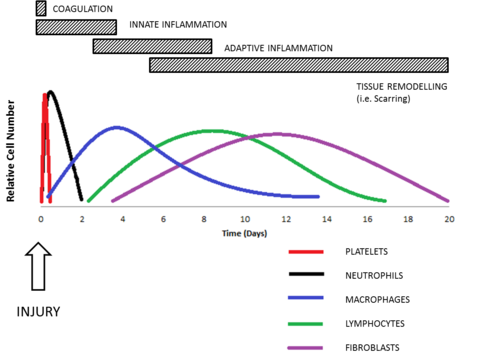Difference between revisions of "Acute Inflammation - Introduction"
Jump to navigation
Jump to search
Rjfrancisrvc (talk | contribs) (→Cells) |
|||
| Line 51: | Line 51: | ||
==Cells== | ==Cells== | ||
| − | + | [[File:WBC Migration Graph.png|thumb|right|500px|Graph illustrating the cellular response to inflammation]] | |
* The classical cells of acute inflammation are [[Neutrophils|neutrophils]], [[Eosinophils|eosinophils]], [[Macrophages|macrophages]], [[Mast Cells|mast cells]] and [[Basophils|basophils]]. | * The classical cells of acute inflammation are [[Neutrophils|neutrophils]], [[Eosinophils|eosinophils]], [[Macrophages|macrophages]], [[Mast Cells|mast cells]] and [[Basophils|basophils]]. | ||
** [[Macrophages|Macrophages]] are a common feature of acute and chronic inflammation. | ** [[Macrophages|Macrophages]] are a common feature of acute and chronic inflammation. | ||
Revision as of 12:18, 25 April 2012
Introduction
- Acute inflammation is characterised sudden onset and may last for a few hours to a few days.
- Vascular, humoral and cellular alterations cause the 5 cardinal signs as a result of exposure of tissues to various causes.
- Acute inflammation can:
- Be fatal
- Resolve by regeneration in association with the host defence mechanisms.
- May be assisted by therapeutic measures.
- Undergo repair by fibrosis.
- Become chronic.
- First goes through a subacute phase.
- Is dependent upon the persistence of the agent and the amount of damage caused.
Sequence of Events
- The following sequence of events is provoked by the presence of the irritant.
- Momentary vasoconstriction
- Following contact with the irritant, there is momentary vasoconstriction of the blood vessels in the affected area.
- This is reversed within minutes.
- Dilation of the blood vessels
- Initially, dilation of the capillaries is caused by the release of chemical mediators.
- Arterioles then dilate under the influence of a local axon reflex.
- This gives rise to an initial acceleration of the blood flow to the area.
- This later gives way to a slowing of blood flow, caused by alterations in vascular endothelial permeability and the filling of previously closed capillaries.
- Exudation of fluid
- Follwing the slowing of blood flow and altered capillary permeability, a protein-rich fluid is exudated.
- Margination of leukocytes
- Circulating white blood cells are attracted to the altered endothelial surfaces.
- Emigration of leukocytes
- Leukocytes migrate through the altered endothelium to reach the injured area.
- This is an active process - chemotaxis.
- The cells are attracted to the endothelium by release of proteins, and further into the tissues by factors released from cells in the damaged area.
- The emigrated leukocytes and components of the fluid exudate are also chemotactic.
- More cells and fluid are attracted to the area.
- Emigration of red blood cells
- Erythrocytes migrate through the gaps in the altered endothelium to the damaged tissue.
- Induction of an increase in temperature
- This may occur either locally or systemically.
- A systemic rise in temperature is known as pyrexia.
- Occurs in generalise acute inflammation.
- Pyrogens act on the temperature control centres in the hypothalamus, and are released from:
- Neutrophils, eosinophils and macrophages
- Particulary neutrophils when they begin to phagocytose.
- The cellular coat of gram-negative organisms.
- Necrosis of damaged tissue cells.
- Antigen-antibody complexes.
- Tumours.
- Particularly those which have metastasised
- It may be difficult to separate this from the pyrexia caused by the central necrosis in such tumours.
- Neutrophils, eosinophils and macrophages
Cells
- The classical cells of acute inflammation are neutrophils, eosinophils, macrophages, mast cells and basophils.
- Macrophages are a common feature of acute and chronic inflammation.
